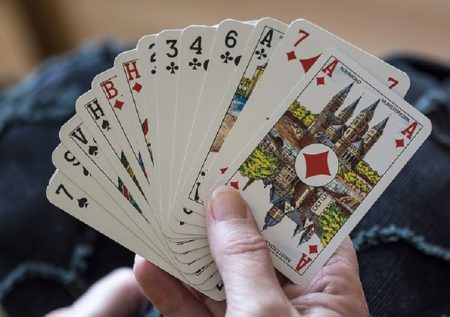

This four-player partnership game, in which the object is to win tricks containing tens, is played in India, especially in the Western states of Maharashtra and Gujarat. I am told that “mendi” is derived from the Gujarati word મીંડું (mindum), which means zero but refers to the 10, which is the only playing card that includes a zero. The word “kot” is used in several South Asian card games for a victory in which the opponents score nothing. However, as with many Indian names transcribed to English, other spellings are also used, for example Mendhi Coat where mendhi is interpreted as the Marathi word for ‘sheep’, or even Mendhi Goat.
There are four players in two teams, partners sitting opposite. Deal and play are anticlockwise.
A standard international 52-card pack is used. The cards of each suit rank from high to low A-K-Q-J-10-9-8-7-6-5-4-3-2.
The first dealer is chosen by drawing cards from a shuffled pack – it can be agreed that the player who draws the highest or the lowest card deals. The cards drawn can also be used to determine the partnerships, the players who draw the highest cards forming a team against the players who draw the lowest cards. Subsequently the dealer is always a member of the losing team of the previous deal – see winning.
The dealer shuffles and deals 13 cards to each player: first a batch of five to each and the remainder in batches of four.
There are several different methods for choosing the trump suit (hukum) – the players should decide before the start of a session which will be used. Here are three possibilities:
The player to dealer’s right begins by leading any card to the first trick. Players must follow suit if possible; a player who is unable to follow suit may play any card. A trick that contains no trumps is won by the highest card of the suit led. If any trumps are played, the highest trump wins. The winner of the trick gathers the cards, adds them to the pile of tricks won by his or her team, and leads to the next trick.
If the game is played with a closed trump (band hukum) there are two versions of the rules and players must agree before the start of the game which to use. Version (a) During the play, as soon as a player is unable to follow suit, the card set aside is revealed and its suit is trump for the deal. The revealed trump card is returned to the owner’s hand. The player who was unable to follow suit may play any card to this trick: there is no obligation to play a trump. Version (b) During the play, a player who is unable to follow suit has the option to ask for the trump to be revealed immediately before playing a card to the trick, but need not do so. If no one has asked for trump before the end of a trick, there are no trumps and the trick is won by the highest card of the suit that was led.
When a player asks for the trump, the card set aside is revealed and its suit counts as trump from the moment when trump is revealed and for all subsequent tricks. The revealed trump card is returned to the owner’s hand.
The player who asked for the trump suit is obliged to play a trump to the trick in which the question was asked, unless he or she holds no cards of the revealed suit in which case any card may be played. Any cards of the trump suit played before the trump was revealed do not count as a trumps – even if they were played to the same trick in which the trump was revealed.
The side that has three or four tens in its tricks wins the deal. If each side has two tens, then the winners are the team that won seven or more tricks.
Winning by capturing all four tens is known as mendikot. Taking all thriteen tricks is a 52-card mendikot or whitewash.
There seems to be no formal method of scoring. The aim is simply to win as often as possible, a win by mendikot being regarded as better than an ordinary win.
The result determines which member of the losing team should deal next, as follows:
It is possible for six or even eight people to play as two equal teams, each player sitting between two opponents. In this case the four twos are discarded from the deck, so that the reamining 48 cards can be dealt equally to the players.
A similar game is played in Northern India under the name Dehla Pakad. The chief difference is that in Dehla Pakad tricks are gathered in only when a player wins two consecutive tricks.